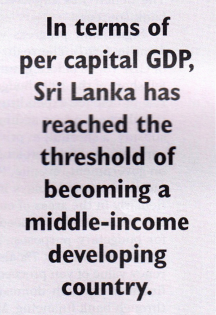The Reports from the Central Bank. he official figures for the state of the economy was released last month by the Central Bank of Sri Lanka. The Central Bank Annual Report said that in 1996 the Gross Domestic Product (GDP) grew by 3.8% in real terms. This was lower than the average growth rate of 5.5% in the previous five years. The slowing down of the economy in 1996 was mainly an outcome of the prolonged drought which had adverse implications for agriculture, electricity generation and industrial output. The GDP grew by only 3.1% as the net income from abroad deteriorated significantly, due to a reduction in investment income receipts and an increase in interest payments on foreign debt in 1996, in contrast to its improvement in 1905. Thin reduction in investment income receipts was a result of the drop in international reserves due to balance of payments deficits in 1995 and 1996, and lower international interest rates.
The Central Bank report said ‘the GDP at current market prices was estimated at Rs 768,934 million. The estimated mid-year population increased by 1.1% to 18.315 million in 1996. Accordingly, the per capita GDP rose to Rs 41,984 (US8 760) in 1996. In terms of per capital GDP, Sri Lanka has reached the threshold of becoming a middle-income developing country. This calls for an early preparation for a gradual reduction in the access to extremely concessional assistance from the donor community, which implies that Sri Lanka would have to rely on other sources including international financial markets to finance its future investment.’

The Central Bank also reported that the general price levels increased sharply in 1996. The Colombo Consumers’ Price Index (CCPI), which is the official price index used for monitoring inflation in the country, increased by 15.9% on an annual average basis in 1996, compared with 7.7% in 1995. The Greater Colombo Consumers’ Price Index (GCPI), which has a wider area coverage than the CCPI, increased by 14.7% in 1996
compared with 3.9% in 1995. The Wholesale Price Index (WPI), which measures price movements at the primary market level, increased by 20.5% during the year. The higher rate of increase in the WPI compared with the consumer price indices was mainly attributed to the increases in export prices. The GNP Deflator (GNDP), which has the widest coverage of goods and services produced in the country, was estimated to have risen by 12.3% in 1996, compared with 8.3% in the previous year. The price increases in 1996 were owing to temporary supply shortages of domestic food items, particularly paddy and coconut, due to the drought, corrective upward adjustments of administered prices of wheat flour, fuel including kerosene, electricity and transport fares, increased import prices, increased cost of production due to higher wages in some sectors and higher energy costs. Of these, the largest impact came from the rise in food prices, which accounted for more than 80% of the increase in the CCPI. In addition to the effect of the drought on food prices, a 20% increase in the average international price of wheat compelled the Government to raise the domestic price of wheat flour to reduce the rising cost of the wheat flour subsidy. The increase in excise duties on alcohol and cigarettes also had a marginal impact on prices. These, and increases in other administered prices, raised consumer prices by 2% points in 1996.
If the corrective price adjustments had not been made, the immediate increase in prices would have been much less. However, in this situation, the Government would have been compelled to resort to expansionary financing to meet the additional cost of the wheat flour subsidy. This would have led to a further buildup of inflationary pressure in the economy, which would have prevailed over a much longer period


